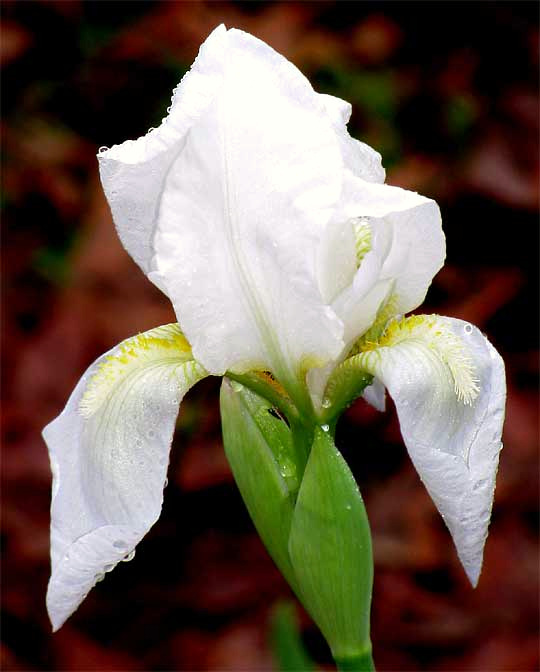Excerpts from Jim Conrad's
Naturalist Newsletter
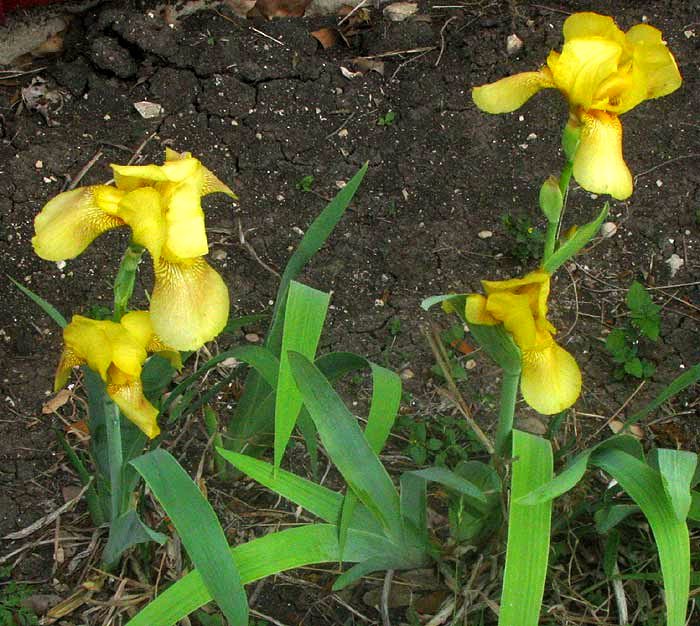
from the the April 28, 2013 Newsletter issued from the Frio Canyon Nature Education Center in northern Uvalde County, southwestern Texas, on the southern border of the Edwards Plateau; elevation ~1750m (~5750 ft); N29.62°, W99.86°; USA
LEMONYELLOW IRIS
Already a couple of months ago irises in Uvalde 35 miles south of us and 780 feet lower in elevation were blossoming, but here the flowers on our irises beside the cabin didn't open until this week. You can see a couple of them above.
Now, an iris is a wonderful thing, something you just want to stand and look at when it blooms, but you can't say much more about its loveliness and desirability than that -- without getting saccharine or maudlin, at least -- so here we'll talk about something else interesting about it, which is its identity.
For, between 260 and 300 iris species are thought to exist worldwide. Many species can show up in our gardens, and the species have been hybridized and gene-manipulated to the point that it's almost funny. In other words, when you see an iris, often there's a good story about its ancestry. So, what's the story for the iris in our picture?
Once you have a name, you can look up the history. Therefore, beginning the identification, first you notice that the plant is about knee high with substantial stems overtopping the leaves. That eliminates a good number of species right there, which are essentially stemless or never grow over ankle high. Also, some iris species develop from bulbs while others arise from rhizomes. With a finger I poked around enough in the dirt at our iris's base to get a peek at a rhizome, not a bulb, so that field mark also eliminated quite a few species. Next a blossom was analyzed. You can see one in all its yellow splendiferousness below:
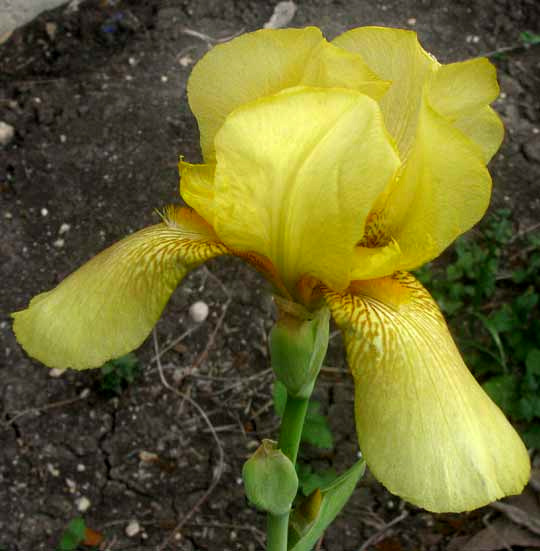
Iris blossoms have evolved features not found in "ordinary" flowers. To be introduced to some terms and concepts peculiar to iris flowers -- such as the style arm, falls, stigmatic lip and standard -- visit my page at http://www.backyardnature.net/fl_iris.htm.
On our pretty, yellow blossom it's worth noting that at the base of the "falls" -- the large, petal-like items descending with dark reticulations at their bases -- there's a line of dense, stiff hairs known as the "beard." The falls of many iris species don't have beards. Also notice that the falls don't narrow to slender "hafts" at their bases, and that the three, yellow, petal-like items rising upwards don't narrow to "claws," which occur in many species. Now let's get closer, where you can more easily see the erect, fuzzy beard at the base of one of the falls, below:
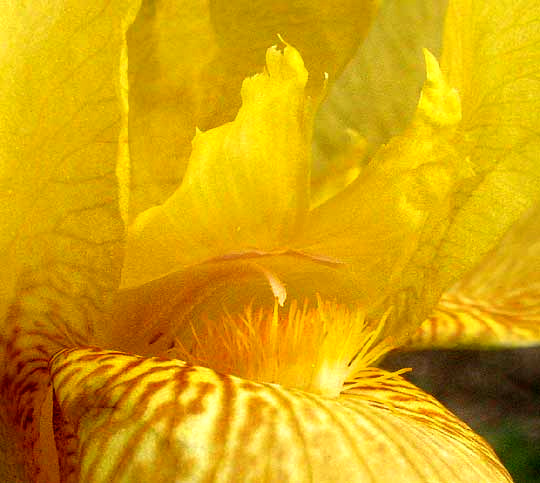
Notice the single slender item arcing above the beard, with its tip pointing downward into the beard's center. That's one of the blossom's three stamens. Notice that above the stamen there's a broad, canopy-like affair notched deeply at its tip, and shallowly incised along its margins. That's the "style arm," which turns out to be part of the female pistil. The style arm is actually a much modified style, a style being the "neck" between any flower's ovary and its pollen-gathering stigma. Suspended from the style arm, right above the stamen's tip, is a low, broad lip-like thing. That's the stigma, where pollinators entering the flower searching for nectar are encouraged to leave their pollen grains to germinate, even as they pick up this flower's pollen from the stamen just beyond the stigma.
Stigma arms in some species are conspicuously fringed, are variously narrow or wide, colored differently, etc., so stigma arm configuration is important.
In my old Bailey's Manual of Cultivated Plants, our yellow iris keys out neatly to Iris flavescens, considered an heirloom species and often referred to as the Lemonyellow Iris. However, my Bailey's is old and the world of taxonomy has changed with the advent of genetic sequencing. According to the USDA's Integrated Taxonomic Information System, Iris flavescens now is lumped into the older species IRIS GERMANICA, the German Iris, a European hybrid itself, and believed to be the ancestor of many, if not most, of modern "bearded" irises featured in gardens the world over.
By the way, as the authority on our Lemonyellow Iris's taxonomy, the USDA's Integrated Taxonomic Information System depends on a South African man named Peter Goldblatt. In the early 1970s when I worked at the Missouri Botanical Gardens, many mornings I'd be busily at work when the freshly PhD'd Peter Goldblatt, a little fellow who favored turtleneck sweaters and tight jeans, would stroll in late with an irrepressibly insouciant air about him, and I figured he'd never get anyplace in the world. But now he's become the world's foremost expert on the Iris Family, and I'm the one who soon gave up serious taxonomy, and that's how the world turns.
Peter is still at Missouri serving as a Senior Curator, having authored several classic botanical texts on the Iris Family.
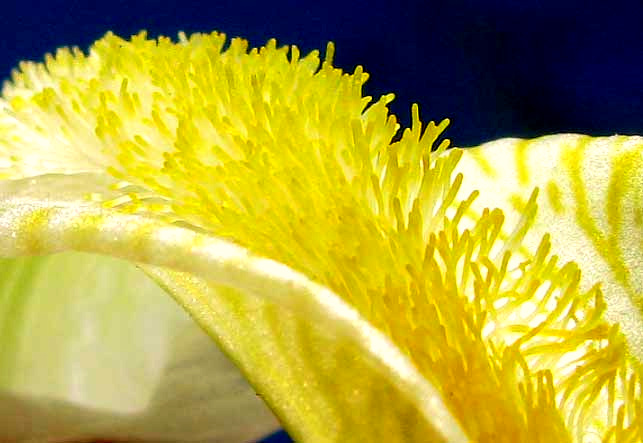
from the the February 16, 2009 Newsletter, issued from the forest near Natchez, Mississippi; elevation ~400ft (120m), ~N31.47°, ~W91.29°:
MYSTERY PICTURES
What's that above?
Here's a hint: This week not only did the Chipping Sparrows start chipping but also the irises began blooming. In town the irises have been out for the last week or so, but it's warmer there.
So, the picture shows a certain twisty view of one of Karen's irises. Specifically, the slender, yellow things are "hairs" of the "beard" running down the iris's "falls," which normally is overtopped by the overarching "style arm" bearing a single stamen. To understand, you may need to visit my Iris Flower Page at http://www.backyardnature.net/fl_iris.htm.
Once you can visualize the falls and style arm, take a look at an equally surreal view, and just as pretty, of the same blossom's style arm, bearing its single stamen beneath it, arching over the falls in the above picture, but shown from a different angle, below:
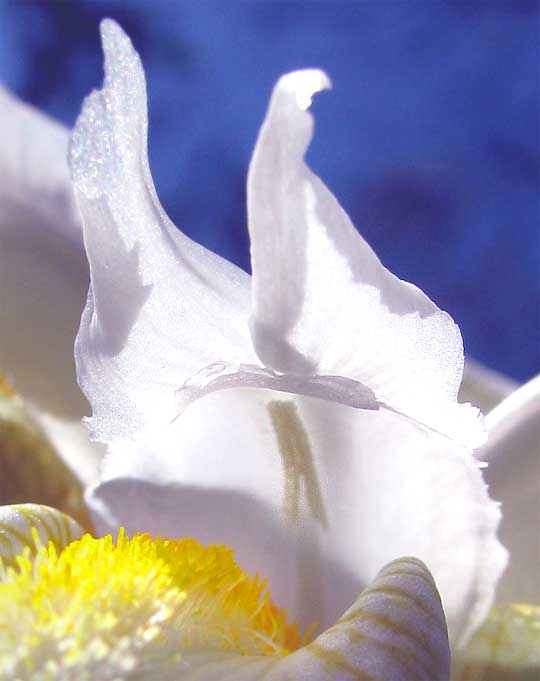 .
.
If you still can't visualize how all the parts fit together, a portrait of a single iris flower is shown below:
